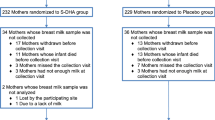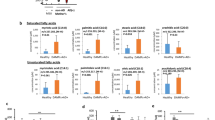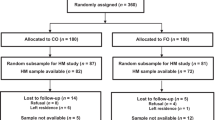Abstract
Objective: To evaluate whether levels of n-6 long chain polyunsaturated fatty acids (LCPs) in human breast milk are related to the mother’s atopic constitution, and whether a decreased level can be restored by gamma-linolenic acid supplementation.
Design: Cross-sectional study and dietary supplementation trial.
Subjects: 20 atopic mothers and 20 non-atopic mothers (controls), all lactating.
Setting: General population.
Interventions: The atopic mothers were randomly assigned to low (n=10) or high (n=10) dosage oral supplementation with oral borage oil for one week (230 or 460 mg gamma-linolenic acid (18:3n-6) per day).
Main outcome measures: Essential fatty acid composition of the breast milk total fat fraction, determined by gas liquid chromatography.
Results: Arachidonic acid (20:4n-6) was lower in breast milk of atopic mothers compared with non-atopic mothers (0.39 wt% vs 0.46 wt%, difference −0.07% wt% (95% confidence limits −0.13, −0.01 wt%; P<0.05). The ratio between linoleic acid and the sum of n-6 derivatives did not differ between these groups, indicating no difference in delta-6-desaturase (D6D) activity. Supplementation of the atopic mothers significantly increased the levels of gamma-linolenic acid and dihomo-gamma-linolenic acid in breast milk in a dose-related way, but the level of arachidonic acid was not increased.
Conclusion: We found a decreased level of arachidonic acid in breast milk in atopic compared to non-atopic mothers, but no indication that the rate-limiting enzymatic step (D6D) is involved. Supplementation increased the precursor pool but did not restore the level of arachidonic acid. We conclude that atopy is related to a metabolic disturbance beyond the D6D enzymatic step. A low level of arachidonic acid in breast milk may be a risk factor for the development of atopy in the infant, especially when the possible underlying metabolic disturbance of EFA metabolism is inherited by the child.
Sponsorship: F Hoffman-La Roche (Basel, Switzerland) and Friesland Dairy Foods (Leeuwarden, The Netherlands).
European Journal of Clinical Nutrition (2000) 54, 234–238
This is a preview of subscription content, access via your institution
Access options
Subscribe to this journal
Receive 12 print issues and online access
$259.00 per year
only $21.58 per issue
Buy this article
- Purchase on Springer Link
- Instant access to full article PDF
Prices may be subject to local taxes which are calculated during checkout
Similar content being viewed by others
Author information
Authors and Affiliations
Contributions
Guarantor: C. Thijs
Contributors: CT was project leader, responsible for design and organization of the study, supervision of the field work and data analysis, and completion of the manuscript. AvH was responsible for supervision of laboratory analyses. IP was a research fellow and carried out field work, analysis and preparation of the manuscript. AM is a dietician and carried out field work. PvdB supervised the project.
Corresponding author
Rights and permissions
About this article
Cite this article
Thijs, C., van Houwelingen, A., Poorterman, I. et al. Essential fatty acids in breast milk of atopic mothers: comparison with non-atopic mothers, and effect of borage oil supplementation. Eur J Clin Nutr 54, 234–238 (2000). https://doi.org/10.1038/sj.ejcn.1600926
Received:
Revised:
Accepted:
Published:
Issue Date:
DOI: https://doi.org/10.1038/sj.ejcn.1600926
Keywords
This article is cited by
-
How changes in nutrition have influenced the development of allergic diseases in childhood
Italian Journal of Pediatrics (2012)
-
n‐3 Polyunsaturated Fatty Acids and Atopy in Korean Preschoolers
Lipids (2007)
-
Polyunsaturated fatty acids regulate cytokine and prostaglandin E2 production by respiratory cells in response to mast cell mediators
Lipids (2006)
-
Polyunsaturated n−3 fatty acids and the development of atopic disease
Lipids (2001)



